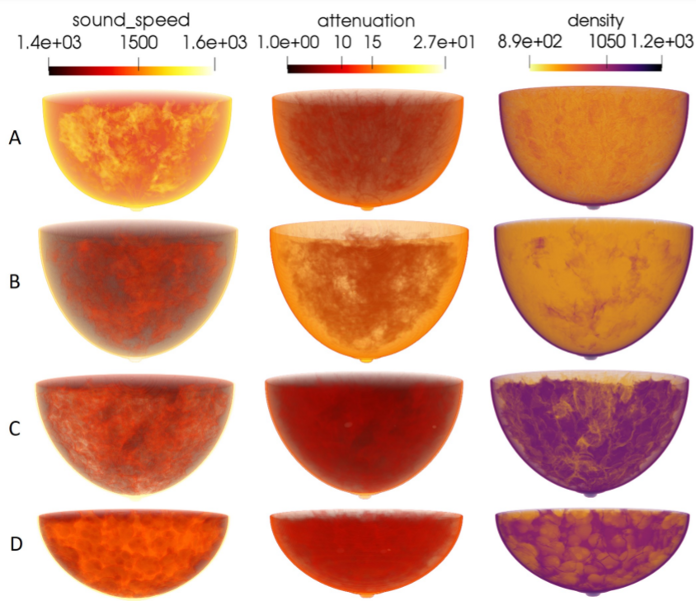Virtual imaging trials for ultrasound computed tomography
Computer-simulation studies, also known as virtual imaging trials, provide researchers with an economical and convenient route to systematically explore imaging system designs and image reconstruction methods. When simulating an imaging technology intended for clinical use, it is essential to employ realistic numerical phantoms that can facilitate the objective, or task-based, assessment of image quality. Moreover, when computing objective image quality measures, an ensemble of such phantoms should be employed that display the variability in anatomy and object properties that is representative of the to-be-imaged patient cohort. Such stochastic phantoms for clinically relevant applications of ultrasound computed tomography (USCT) are currently lacking.
In this work, a methodology for producing realistic three-dimensional (3D) numerical breast phantoms for enabling clinically-relevant computer-simulation studies of USCT breast imaging is presented. By extending and adapting an existing stochastic 3D breast phantom for use with USCT, methods for creating ensembles of numerical acoustic breast phantoms are established. These breast phantoms will possess clinically relevant variations in breast size, composition, acoustic properties, tumor locations, and tissue textures. Examples of breast phantoms produced by use of the proposed methods and a collection of 52 sets of simulated USCT measurement data have been made open source for use in image reconstruction development.
Database
- Fu Li, Umberto Villa, Seonyeong Park, and Mark A. Anastasio, “2D Acoustic Numerical Breast Phantoms and USCT Measurement Data,” (2021); [Online] Available: https://doi.org/10.7910/DVN/CUFVKE
- Fu Li, Umberto Villa, Seonyeong Park, and Mark A. Anastasio,“3D Acoustic Numerical Breast Phantoms,” (2021); [Online] Available: https://doi.org/10.7910/DVN/KBYQQ7
Publication
- F. Li, U. Villa, S. Park and M. A. Anastasio, “Three-dimensional stochastic numerical breast phantoms for enabling virtual imaging trials of ultrasound computed tomography,” in IEEE Transactions on Ultrasonics, Ferroelectrics, and Frequency Control, 2021.https://doi.org/10.1109/TUFFC.2021.3112544
Virtual imaging trials for photoacoustic computed tomography
Virtual imaging trials (VITs) permit imaging experiments to be simulated in silico by use of clinically relevant numerical phantoms and computational models of the image formation process. Due to their enabling potential, VIT methodologies have become an active topic of research for emerging modalities, such as photoacoustic computed tomography (PACT) also known as optoacoustic tomography.
We are actively engaged in the development of a framework for conducting VITs for 3D PACT breast imaging, in collaboration with Dr. Alexander Oraevsky’s team at TomoWave Laboratories. Our framework includes: the establishment of realistic numerical phantoms, that describe the anatomical and functional properties of the female breast, and coupled-physics-based computational models of the image formation process and data-acquisition. Such in silico imaging trials can include large (virtual) patient cohorts and specifically designed diagnostic tasks that cannot be done easily or ethically with human subjects. The framework for conducting comprehensive, in silico VITs will enable studies that would not be possible using simplistic physical phantoms or human subjects and will inform the design of clinically viable and effective breast PACT systems tailored to a variety of clinical tasks.
- Coupled-physics-based computational models of the image formation process and data-acquisition
Optical simulation |
Acoustic simulation |
- Realistic numerical phantom that describes the anatomical and functional properties of the female breast
Tissue-labeled structure |
Oxygen saturation |
Optical absorption coefficient |
Speed of sound |
Initial pressure |
Image reconstructed by filtered back projection |
Publication
- Seonyeong Park, Umberto Villa, Richard Su, Alexander Oraevsky, Frank J. Brooks, Mark A. Anastasio, “Realistic three-dimensional optoacoustic tomography imaging trials using the VICTRE breast phantom of FDA (Conference Presentation),” Proc. SPIE 11240, Photons Plus Ultrasound: Imaging and Sensing 2020, 112401H (6 March 2020); https://doi.org/10.1117/12.2552380
